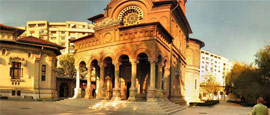Bucharest History
Romania’s capital was once the principal city in the country of Wallachia, giving Bucharest a fascinating past that dates back to 70BC when the area was settled by the Geto-Dacian peoples.
But its most colourful claim to fame didn’t arrive until the 15th century when the notorious Tepes clan took control of the city itself. This was when Vlad Tepes, better known to posterity as Vlad Dracula or Vlad the Impaler, took to his bloodthirsty habit of skewering opponents and Ottoman troops on spikes.
Much of Wallachia’s 15th century existence was dominated by ongoing battles with the Imperial forces of Istanbul and by the 17th century, Bucharest itself had fallen. The end of the fighting brought trade to the city, with the result that it was one of the wealthiest cities in Europe by the time it was made capital of modern Romania in 1862.
More success was to come and by 1900, Bucharest was home to so many elegant parks and stately palaces, it became known as Little Paris.
But the fall of the Austro-Hungarian Empire and the rise of the Nazis brought disaster to Bucharest and it suffered badly during WWII when Romania, initially neutral, joined the war on the Axis side. A terrible earthquake in 1940 compounded the damage and by the time the Soviets arrived in 1944, much of the city was gone.
Rebuilding under Communist rule was an altogether less elegant affair, with Bucharest falling prey to ugly Stalinist blocks. Some of these crumbled another earthquake hit in 1977, but dictator Nicolae Ceauşescu ensured that the subsequent rebuilding was also done along Communist-inspired lines.
In 1989 Romania emerged from Soviet rule, but not before the execution of Ceauşescu and his wife watched by jubilant crowds in Palace Square. Since then, Bucharest has begun reinventing itself with glittering modern temples to lucre joining Stalinist blocks in the city skyline.
Did you know?
• The first road in Bucharest, Drumul de Lemm, was known as ‘the Wooden Road’.
• Bucharest got its first bus in 1840, making it a public transport pioneer.
• The Romanian Parliament building is the second largest of its kind in the world.
Do you have any Feedback about this page?
© 2025 Columbus Travel Media Ltd. All rights reserved. No part of this site may be reproduced without our written permission, click here for information on Columbus Content Solutions.




 You know where
You know where